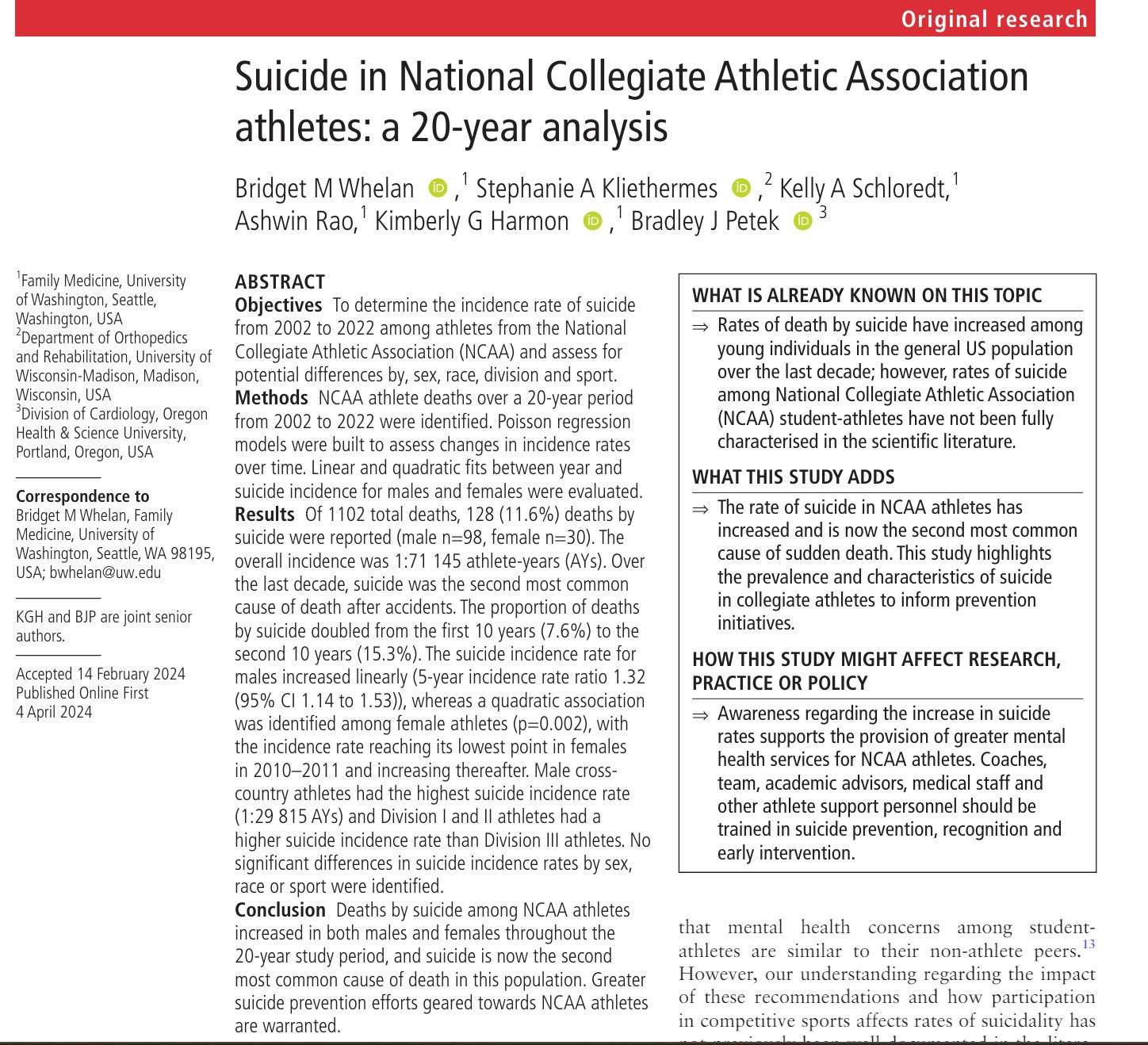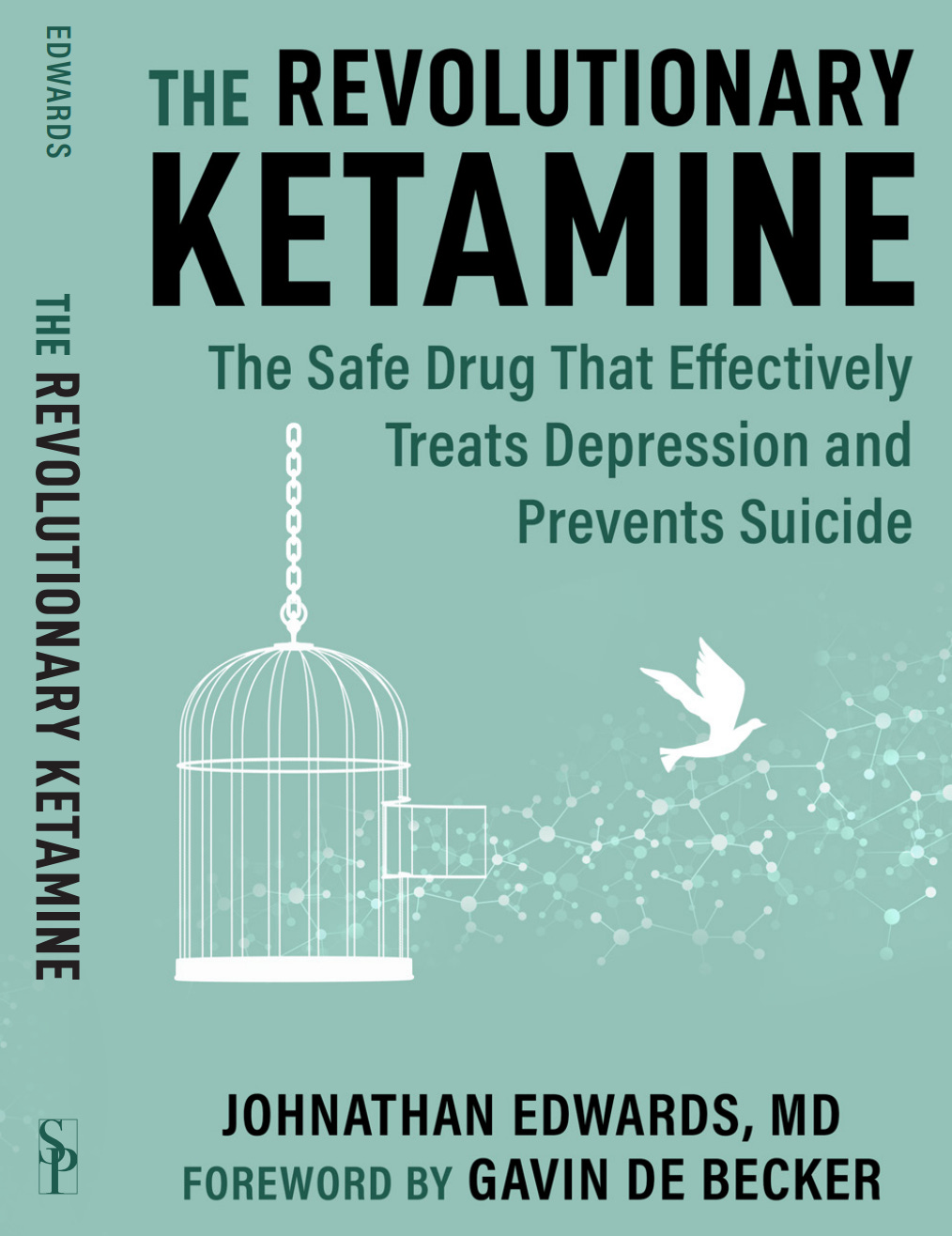Suicides among a surprising population have doubled over the past 20 years
a New Study in British Journal of Sports Medicine
Athletes are generally considered one of the healthiest populations in our society. Yet, the yearly incidence rate of suicide for males and females increased throughout the 20-year study period in a recently published study in the British Journal of Sports Medicine.
I wrote extensively about this phenomenon in The Revolutionary Ketamine and even dedicated a chapter to it. The pressures of school, internal and external performance expectations, time demands, injury, athletic identity, and physical fatigue can lead to depression, mental health problems, and suicide. The key findings are the rate of suicide in NCAA athletes has increased and is now the second most common cause of sudden death. Accidents are the first, but sudden cardiac arrest has certainly also increased recently.
Athletes may also experience harassment and abuse within their sport, including psychological abuse, physical abuse, sexual abuse, hazing, and cyberbullying from the public and members of their team, including peer athletes, coaches, and members of the entourage. Depression, which can lead to suicide, is common in both the young adult general population and athletes. Social media also affects an athlete’s sense of value. This is highlighted in the story of Madison Holleran.
Athletes, both professional and amateur, are competing during a time when levels of self-oriented perfectionism and socially prescribed perfectionism are high. The recent emergence of name, image, and likeness (NIL) deals has placed more pressure than ever on young athletes. Athletes can experience increased feelings of worthlessness, and the potential for suicide becomes conceivable, especially when their athletic career ends.
It was somewhat surprising to see that Cross-country athletes had the highest suicide rates since it’s not physically violent, but is a sport in which athletes endure high levels of physical pain and sport-related injury. This finding correlates with a study reporting track and field athletes are the most likely to experience clinically significant levels of depressive symptoms. This study’s mean age at the time of death was 20 years. Also, in cases of overdose that were not intentional, the death was listed as ‘overdose,’ which may also result in under-reporting suicide.
Despite the recent increased focus on mental health in athletes, death by suicide is increasing. Currently, death by suicide is second leading cause of death in young men aged 20 to 29, and the overall incidence is increasing. It’s easy to say that we need additional mental health resources, including efforts to raise awareness, screening for early risk identification, training coaches and support staff. But we probably need to look more deeply about what we are doing as a society, because whatever we are doing as a society is trending in the wrong direction.
The following is an excerpt from Chapter 7 in The Revolutionary Ketamine:
CHAPTER SEVEN:
ATHLETES, MENTAL ILLNESS, AND SUICIDE
“To show weakness, we’re told, in so many words, is to deserve shame. But I am here to show weakness. And I am not ashamed.” — Mardy Fish
Michael Phelps once said, “For the longest time, I thought asking for help was a sign of weakness because that’s kind of what society teaches us. Well, you know what? If someone wants to call me weak for asking for help. That’s their problem because I’m saving my own life.” Phelp’s quote accurately portrays the current state of athletic’s toward mental health.
Suicide is an important and preventable cause of death among athletes. Junior Seau, Wade Belak, and Jovan Belcher have the following in common: they all reached their dreams of becoming successful professional athletes and have ended their own lives for different reasons. Hundreds of athletes are opening up about mental illness in the NFL (football), UFC (mixed martial arts), NHL (hockey), MLB (baseball), ATP (tennis), and Olympic sports; and all sports governing bodies have recently prioritized mental health concerns for athletes. Chronic traumatic encephalopathy (CTE), depression, and suicide make headline news nowadays. Many athletes are opening up and speaking about their experiences with psychotherapy and psychedelics and how it has helped them guide their careers and lives.
ESPN commentator and journalist Kate Fagan wrote a riveting book titled, “What Made Maddy Run.” It is the story of a collegiate athlete Madison Holleran suffering from severe depression. She excelled in academics, was incredibly popular, was genuinely kind and personable, and a collegiate track athlete at the University of Pennsylvania. On January 17th, 2014, she ran off the rooftop of a parking garage near the university, and fell to her death. Holleran’s suicide rocked the University of Pennsylvania campus. In fact, in a span of 10 years, the University of Pennsylvania has recorded at least 14 student suicides, including Holleran. College counseling centers became inundated with mental health crises, and the university responded by hiring additional counselors and cutting wait times. In 2019, Gregory Eells, the head of counseling and psychological services (CAPS) at Penn, died of suicide, highlighting the complexity of the school’s continuing battle against suicide.
Mental health support is increasing in universities as there is a better sense of its importance in academia. Still, the stigma associated with mental health problems has not changed proportionately. For example, as governments and educational bodies emphasize recruiting ethnic minority students to increase diversity, yet schools may not be equipped to handle mental health challenges.
The risk factors associated with depression in university undergraduate students are complex. Some of the risk factors include (Mofatteh):
Low self-esteem and confidence
Lack of social engagement
Infrequent family visits
Excessive internet and social media usage
Belonging to minority groups
Inadequate physical activity and obesity
Loneliness
Underlying mental health condition
Studying in a foreign language
Workload pressure
Low family income/childhood poverty
Eating disorders
Tobacco, drug, and alcohol usage
Being bullied by staff
Gender
Inadequate sleep
Wrong expectations
Subject mastery
Exams and assessments
Inadequate financial support from the university
Lack of social support network
Sexual victimization
Year of study
Unfamiliar environment
Age
Athletes have all of those risk factors as well as living up to multiple expectations from coaches, family, friends, and sponsors. Student-athletes face unique pressures that involve balancing homework, social life, tests, vacations, relationships, and social gatherings while developing into young adults. For example, a survey of nearly 3000 students in five US universities showed that more than half experienced anxiety and depression (Zivin). Factors such as injury, failure, and drugs may lead to an increased risk of depression and suicidal behavior in anyone (Rao).
Social media is gaining even more significance among high school and college athletes with the NCAA now allowing name, image, and likeness sponsorship deals. College athletes will undoubtedly be focusing on social media more than ever before. Fagan's book highlights Madison Holleran's social media activities and her attempts to appear perfect in a world she could not control. Even the images she posted sixty minutes before jumping were filtered with an ethereal quality (Fagan). Madison's life story reveals a unique perspective on the struggles of young college student-athletes suffering from mental illness. Madison effortlessly attained perfectionism in high school but could not obtain it at an Ivy League school where she was just one of many. The pressure was too much, and she became isolated, constantly fighting her battle with depression; her story reveals today's mounting pressures of being perfect in an age of relentless connectivity and social media overload. Madison was undergoing intense therapy before her suicide; if she had been able to undergo ketamine therapy for her severe depression, could the outcome have been different?
Everyone presents an edited version of life on social media, and shared moments reflect an ideal life. If you were to look up a definition of perfection, it would state - lacking all faults or defects or satisfying all requirements. Young women growing up on Instagram spend inordinate amounts of time absorbing others' filtered images while paying less attention to the reality in front of them. Nobody posts the truth on social media; it's all smoke and mirrors. Instagram is passed off as real life, and people filter their photos, brightening their images so as not to show the sadness they might genuinely feel.
Student and athletes alike may have many Instagram friends, but all they have mastered is the art of being alone in a crowded room without considering the cost. Psychologists Jonathan Haidt and Jean Twenge have been tracking the attitudes and behaviors of teens and young adults for years (Twenge), and they believe teens spend less time nowadays with their friends in person, and more using social media and other electronic means of communication. In many classrooms, students are entirely absorbed in their smartphones, sitting in complete silence. A Journal of Adolescence article showed that in 36 out of 37 countries, loneliness at school has increased since 2012 (Twenge). Many students describe having shallow friendships and superfluous romantic relationships mediated by social media. In today’s society, we can be two feet from a friend or loved one, yet those two people may as well be two thousand miles apart, and the irony is that both parties are lonely. People often have a thousand social media friends that they’ve never actually talked to, choosing instead to bounce one-line messages hundreds of times per day. Jonathan Haidt calls this “compare and despair” - you don’t actually get social relationships; you get weak, fake social links. As Fagan says in her book, this is not friendship; this is a distraction.






Great article on a topic which needs to be discussed openly and without shame. It is also key to note that High School women's X/C also has the highest rate of injuries.....a coincidence? I don't think so. Metabolic health plays a big and critical part of both physical health and robustness as well as mental and emotional stability. The messaging our athletic youth are getting undermines the very goals of sport and competition....to be better in every way.